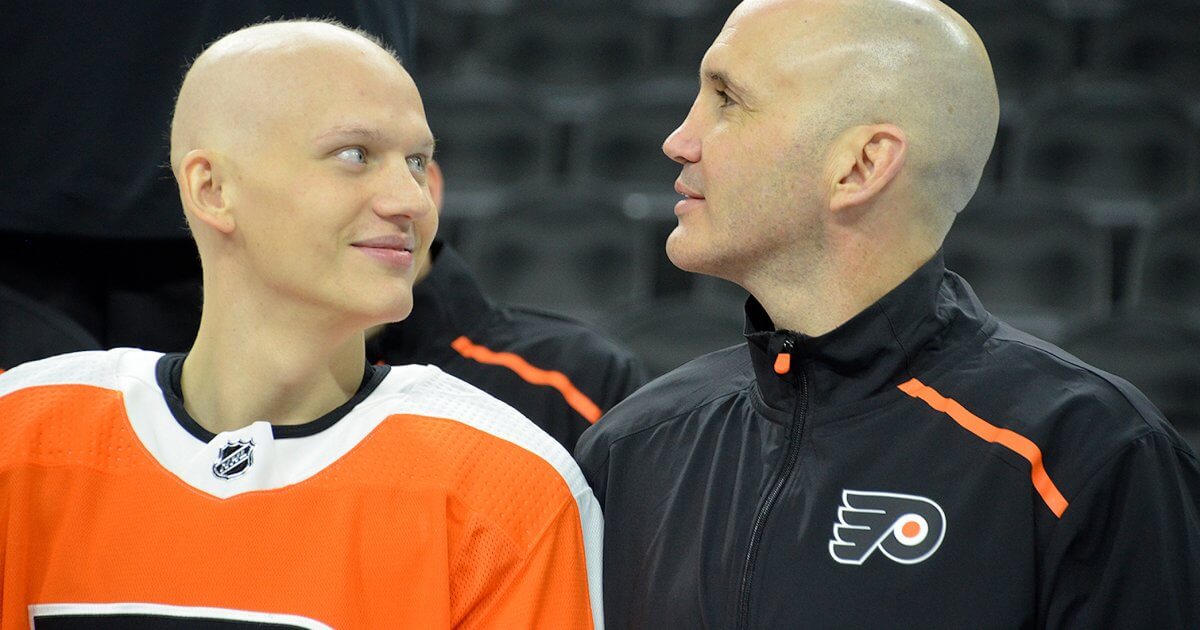Hockey player, Oskar Lindblom, 23, hit the ice on Tuesday, reconnecting with a few of his Philadelphia Flyers teammates for an informal practice session while continuing to undergo final chemotherapy treatments for Ewing's Sarcoma, a rare form of cancer. "I can see the light at the end of the tunnel now,” Lindblom told the Philadelphia Inquirer. “I can't complain. People have had it worse. I'm happy to be where I am right now.”
Read More“He’s An Impressive Human”
Of his chemotherapy treatments, he said, "they're going great. That's the only thing I'm waiting for now to get done with my chemo and get back with the team and play some hockey. That would be unreal to get back to real life again and have fun," he said.
Lindblom, a native of Sweden, was having a breakout season with an impressive 11 goals when, on December 13th, the Flyers announced he’d been diagnosed with Ewing’s Sarcoma. Fans rallied around him under the hashtag #OskarStrong and the Flyers dedicated the season suspended on March 12 due to the pandemic — to Lindblom. Tournament play begins in August.

Beloved in Philly, Lindblom, 23, has been the focus of an outpouring of support from fans and teammates, who rallied under the hashag #OskarStrong.
"He's an impressive human; he's handled it much better than I probably would.” said Flyers' center Kevin Hayes, whose parents are both cancer survivors, according to the Inquirer. “It's inspiring, and he puts a smile to your face and makes you realize your problems aren't as serious as they seem to be."
RELATED: Fit & Fighting: The Inspirational Athletes Changing the Ways We Think About Cancer
General manager Chuck Fletcher said, "He looked really good on the ice. His hands are still there. It is remarkable to think that with all the treatments he has had, he was able to go out there today and still show the skill and still have the stamina to skate for 35-40 minutes." Fletcher called it "a great sign.”
What Is Ewing's Sarcoma?
A cancer that grows in the bone or soft tissue, Ewing’s Sarcoma can develop in the bones and other parts of the body. It's most common in adolescents and young adults, from teen years to the mid-20s, according to the National Cancer Institute. Signs of the disease include:
- Pain and/or swelling, usually in the arms, legs, chest, back, or pelvis.
- A lump (which may feel soft and warm) in the arms, legs, chest, or pelvis
- Fever for no known reason
- A bone that breaks for no known reason
While the Flyers did not reveal details of Lindblom’s case, treatment for Ewing's sarcoma may involve a combination of chemotherapy, radiation, and surgery. treatment plans are determined by the location of the cancer — whether it’s in the bones or soft tissues — and the size of the tumor at the time of diagnosis.
A rare cancer, more than 16,000 new cases diagnosed each year. If cancer is caught early, in a localized stage, the 5-year survival rate for Ewing's sarcoma is around 83%, according to the American Cancer Society.
Genes, Age, and Ancestry
Major advancements in treatment have improved the outlook for those diagnosed with the disease, according to the Mayo Clinic. After completion of treatment, lifelong monitoring is recommended to watch for potential late effects of intense chemotherapy and
RELATED: Fit & Fighting: The Inspirational Athletes Changing the Ways We Think About Cancer
radiation. The disease begins when a cell develops changes in its DNA — most often a gene called EWSR1. The mutated gene tells cells to multiply quickly, resulting in a mass (tumor) of abnormal cells that can invade and destroy healthy body tissue. When doctors suspect Ewing’s sarcoma, they may test cancer cells to look for changes in this gene.
Risk factors include age — the disease is most often seen in children and teenagers — and ancestry. Ewing’s sarcoma is more common in people of European ancestry and much less commonly diagnosed in people of African and East Asian descent.
Learn more about SurvivorNet's rigorous medical review process.


